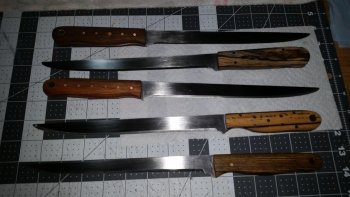M
Michael Minto
Guest
On a couple of occasions I have made a blade that was VERY difficult to put a bevel on. I would keep trying to grind in an edge bevel on my belt sander (using a jig for consistency), but alas, would only grind away more and more steel, without getting the knife sharp (one was D2, the others, 440C). I lost a couple of blades to this. I'm thinking they were about Rc60/61 - coulda been higher, don't have a tester). Has this happened to anyone? Got a fix? Can bevel angle (too high/too low) be part of the issue? Thanks for any useful info. Mike
Last edited by a moderator:


